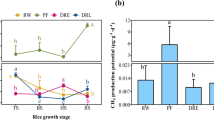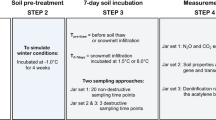Abstract
We examined the importance of temperature (7°C or 15°C) and soil moisture regime (saturated or field capacity) on the carbon (C) balance of arctic tussock tundra microcosms (intact blocks of soil and vegetation) in growth chambers over an 81-day simulated growing season. We measured gaseous CO2 exchanges, methane (CH4) emissions, and dissolved C losses on intact blocks of tussock (Eriophorum vaginatum) and intertussock (moss-dominated). We hypothesized that under increased temperature and/or enhanced drainage, C losses from ecosystem respiration (CO2 respired by plants and heterotrophs) would exceed gains from gross photosynthesis causing tussock tundra to become a net source of C to the atmosphere. The field capacity moisture regime caused a decrease in net CO2 storage (NEP) in tussock tundra micrososms. This resulted from a stimulation of ecosystem respiration (probably mostly microbial) with enhanced drainage, rather than a decrease in gross photosynthesis. Elevated temperature alone had no effect on NEP because CO2 losses from increased ecosystem respiration at elevated temperature were compensated by increased CO2 uptake (gross photosynthesis). Although CO2 losses from ecosystem respiration were primarily limited by drainage, CH4 emissions, in contrast, were dependent on temperature. Furthermore, substantial dissolved C losses, especially organic C, and important microhabitat differences must be considered in estimating C balance for the tussock tundra system. As much as ∼ 20% of total C fixed in photosynthesis was lost as dissolved organic C. Tussocks stored ∼ 2x more C and emitted 5x more methane than intertussocks. In spite of the limitations of this microcosm experiment, this study has further elucidated the critical role of soil moisture regime and dissolved C losses in regulating net C balance of arctic tussock tundra.
Similar content being viewed by others
References
Abacus (1989) Supernova version I. II. Abacus Concepts, Berkeley
Billings WD (1987) Carbon balance of Alaskan tundra and taiga ecosystems: past, present, and future. Quat Sci Rev 6: 165–177
Billings WD, Luken JO, Mortensen DA, Peterson KM (1982) Arctic tundra: a source or sink for atmospheric carbon dioxide in a changing environment? Oecologia 53: 7–11
Bliss LC, Matveyeva NV (1992) Circumpolar arctic vegetation. In: Chapin FS III, Jefferies RL, Reynolds JF, Shaver GR, Svoboda J, Chu EW (eds) Arctic ecosystems in a changing climate. Academic Press, San Diego, pp 59–86
Chapin FS III (1983) Direct and indirect effects of temperature on arctic plants. Polar Biol 2: 47–52
Chapin FS III, Miller PC, Billings WD, Coyne PI (1980) Carbon and nutrient budgets and their control in coastal tundra. In: Brown J, Miller PC, Teiszen LL, Bunnell FL (eds) An arctic ecosystem. The coastal tundra at Barrow, Alaska. Dowden Hutchinson and Ross. Stroudsburg, pp 458–482
Christensen T (1993) Methane emission from Arctic tundra. Biogeochemistry 21: 117–139
Cicerone RJ, Oremland RS (1988) Biogeochemical aspects of atmospheric methane. Global Biogeochem 21: 117–139
Flanagan RW, Veum AK (1974) Relationships between respiration, weight loss, temperature and moisture in organic residues in tundra. In: Holding AJ et al (eds) Soil organisms and decomposition in tundra. Tundra Biome Steering Committee, Stockholm, pp 249–277
Funk DW, Pullman ER, Peterson KM, Crill P, Billings WD (1994) Influence of water table on carbon dioxide, carbon monoxide, and methane fluxes from taiga bog microcosms. Global Biogeochem Cycles 8: 271–278
Giblin AE, Nadelhoffer KJ, Shaver GR, Laundre JA, McKerrow AJ (1991) Biogeochemical diversity along a riverside topo sequence in arctic Alaska. Ecol Monogr 61: 415–435
Grulke NE, Reichers GH, Oechel WC, Hjelm U, Jaeger C (1990) Carbon balance in tussock tundra under ambient and elevated CO2. Oecologia 83: 485–494
Hinzman LD, Kane DL (1988) Permafrost hydrology of a small arctic watershed. In: Senneset K (ed) Proceedings, Fifth International Permafrost Conference. Tapir, Trondheim, pp 590–595
Hinzman LD, Kane DL (1992) Potential response of an arctic watershed during a period of global warming. J Geophyis Res 97: 2811–2820
Hinzman LD, Kane DL, Benson CS, Everett KR (in press) Energy balance and hydrologic processes in an arctic watershed. In: Reynolds JF, Tenhunen JD (eds) Landscape function: implications for ecosystem response to disturbance. A case study in arctic tundra (Ecological Studies Series). Springer, Berlin Heidelberg New York
Hinzman LD, Kane DL, Gieck RE, Everett KR (1991) Hydrologic and thermal properties of the active layer in the Alaskan Arctic. Cold Regions Sci Technol 19: 95–110
Kane DL (1993) Meteorological and hydrologic studies in the suppost of long-term ecological research. In: Redmond KT, Tharp VL (eds) Proceedings of the Ninth Annual Pacific Climate (PACLIM) Workshop. California Dept of Water Res., Interagency Ecol. Studies Program. Tech. Rep. 34, pp 13–21
Kane DL, Hinzman LD, Benson CS, Liston GE (1991) Snow hydrology of a headwater arctic basin 1. Physical measurements and process studies. Water Resources Institute 27: (6): 1099–1108
Kling GW, Kipphut GW, Miller MC (1990) Arctic lakes and streams as gas conduits to the atmosphere: implications for tundra carbon budgets. Science 251: 298–301
Lashof DA (1989) The dynamic greenhouse: Feedback processes that may influence future concentrations of atmospheric trace gases and climate change. Climate change 14: 213–242
Maxwell B (1992) Arctic climate: potential for change under global warming. In: Chapin FS III, Jefferies RL, Reynolds JF, Shaver GR, Svoboda J, Chu EW (eds) Arctic ecosystems in a changing climate. Academic Press, San Diego, pp 11–34
Maxwell JB, Barrie LA (1989) Atmospheric and climatic change in the Arctic and Antarctic. Ambio 18: 42–49
McKane RB, Rastetter EB, Shaver GR, Nadelhoffer KJ, Giblin AE, Laundre J, Chapin FS III (in press) Analysis of the effects of climate change on C storage in arctic tundra. Ecology
Miller PC (1980) Carbon balance in northern ecosystems and the potential effect of carbon dioxide induced climatic change. Report of a workshop. US Department of Energy, Washington
Nadelhoffer KJ, Giblin AE, Shaver GR, Laundre JL (1991) Effects of temperature and organic matter quality on C, N, and P mineralization in soils from arctic ecosystems. Ecology 72: 242–253
Nadelhoffer KJ, Giblin AE, Shaver GR, Linkins AE (1992) Microbial processes and plant nutrient availability in arctic soils. In: Chapin FS III, Jefferies RL, Reynolds JF, Shaver GR, Svoboda J, Chu EW (eds) Arctic ecosystems in a changing climate. Academic Press, San Diego, pp 281–300
Oechel WC (1989) Nutrient and water flux in a small arctic watershed: an overview. Holarct Ecology 12: 229–237
Oechel WC, Billings WD (1992) Effects of global change on the C balance of arctic plants and ecosystems. In: Chapin FS III, Jefferies RL, Reynolds JF, Shaver GR, Svoboda J, Chu EW (eds) Arctic ecosystems in a changing climate. Academic Press, San Diego, pp 139–168
Oechel WC, Vourlitis GL, Hastings SJ, Bochkarev SA (1995) Change in arctic CO2 flux over two decades: effects of climate change at Barrow, Alaska, Ecol Appl 5: 846–855
Oechel WC, Hastings SJ, Vourlitis G, Jenkins M, Reichers G, Grulke N (1993) Recent change of arctic tundra ecosystems from a net carbon dioxide sink to a source. Nature 361: 520–523
Peterson KM, Billings WD, Reynolds JN (1984) Influence of water table and atmospheric CO2 concentration on the carbon balance of arctic tundra. Arct Alp Res 16: 331–335
Rastetter EB, Ryan MJ, Shaver GR, Melillo JM, Nadelhoffer KJ, Hobbie JE, Aber JD (1991) A general biogeochemical model describing the responses of the C and N cycles in terrestrial ecosystems to changes in CO2, climate, and N deposition. Tree Physiol 9: 101–126
Rastetter EB, McKane RB, Shaver GR, Melillo JM (1992) Changes in carbon storage by terrestrial ecosystems: how C-N interactions restrict responses to CO2 and temperature. Water Air Soil Pollut 64: 327–344
Rastetter EB, McKane RB, Shaver GR, Nadelhoffer KJ, Giblin AE (in press) Analysis of CO2, temperature, and moisture effects on C storage in Alaskan arctic tundra using a general ecosystem model. In: Oechel WC, Holten JI (eds) Global change and arctic terrestrial ecosystems. Springer, Berlin Heidelberg New York
Rodhe H (1990) A comparison of the contribution of various gases to the greenhouse effect. Science 248: 1217–1219
Schlesinger ME, Mitchell JFB (1987) Climate model simulations of the equilibrium climatic response to increased carbon dioxide. Rev Geophys 25: 760–798
Sebacher DI, Harriss RC, Bartlett KB, Sebacher SM, Grice SS (1986) Atmospheric methane sources: Alaskan tundra bogs, an alpine fen, and a subarctic boreal marsh. Tellus 48B: 1–10
Shaver GR, Chapin FS III (1980) Response to fertilization by varilation plant growth forms in an Alaskan tundra: nutrient accumulation and growth. Ecology 61: 662–675
Shaver GR, Chapin FS III (1986) Effect of NPK fertilization on production and biomass of Alaskan tussock tundra. Arc Alp Res 18: 261–268
Shaver GR, Kumerow J (1992) Phenology, resource allocation, and growth of arctic vascular plants. In: Chapin FS III, Jefferies RL, Reynolds JF, Shaver GR, Svoboda J, Chu EW (eds) Arctic ecosystems in a changing climate. Academic Press, San Diego, pp 193–211
Shaver GR, Billings DW, Chapin FS III, Giblin AE, Nadelhoffer KJ, Oechel WC, and Rastetter EB (1992) Global change and the C balance of Arctic ecosystems. Biocience 42: 433–441
Tieszen LL (1973) Photosynthesis and respiration in arctic tundra grasses: field light intensity and temperature responses. Arct Alp Res 5: 239–251
Tieszen LL (1978) Photosynthesis in the principal Barrow species: a summary of field and laboratory responses. In: Tieszen LL (ed) Vegetation and production ecology of an Alaskan arctic tundra. Springer, Berlin Heidelberg New York, pp 621–645
Whalen SC, Reeburgh WR (1990) Consumption of atmospheric methane by tundra soils. Nature 346: 160–162
Whalen SC, Reeburgh WR (1992) Interannual variations in tundra methane emission: a 4-year time series at fixed sites. Global Biogeochem cycles 6: 139–159
Author information
Authors and Affiliations
Rights and permissions
About this article
Cite this article
Johnson, L.C., Shaver, G.R., Giblin, A.E. et al. Effects of drainage and temperature on carbon balance of tussock tundra micrososms. Oecologia 108, 737–748 (1996). https://doi.org/10.1007/BF00329050
Received:
Accepted:
Issue Date:
DOI: https://doi.org/10.1007/BF00329050




